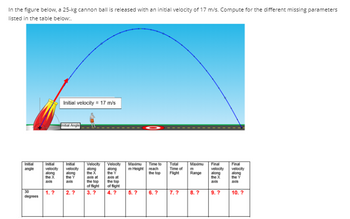
College Physics
11th Edition
ISBN: 9781305952300
Author: Raymond A. Serway, Chris Vuille
Publisher: Cengage Learning
expand_more
expand_more
format_list_bulleted
Concept explainers
Question

Transcribed Image Text:In the figure below, a 25-kg cannon ball is released with an initial velocity of 17 m/s. Compute for the different missing parameters
listed in the table below:.
Initial
angle
30
degrees
Initial
velocity
along
the X
axis
1. ?
Initial velocity = 17 m/s
Inital Angle
Initial
velocity
along
the Y
axis
2.?
Velocity
along
the X
axis at
the top
of fight
3. ?
Velocity
along
the Y
axis at
the top
of flight
4. ?
Maximu
m Height
5.?
Time to
reach
the top
6. ?
Total
Time of m
Flight
Maximu
7.?
Range
8. ?
Final
velocity
along
the X
axis
9.?
Final
velocity
along
the Y
axis
10. ?
Expert Solution
This question has been solved!
Explore an expertly crafted, step-by-step solution for a thorough understanding of key concepts.
Step by stepSolved in 2 steps with 2 images

Knowledge Booster
Learn more about
Need a deep-dive on the concept behind this application? Look no further. Learn more about this topic, physics and related others by exploring similar questions and additional content below.Similar questions
- Doha kicks the ball in a parabolic path. The ball leaves the player’s foot with a speed of 20 m/s, making an angle of 40 o with the horizontal. a) Calculate the maximum height of its trajectory b) Determine its velocity as it hits the ground again. Air resistance is negligible. c) How far from Darshan does the soccer ball land?arrow_forward16. Answer the following questions based on the below diagram. 251_ Viy=1.6m/5 What is the initial velocity of the projectile? What is the maximum height the projectile reaches? What is the final velocity of the projectile?arrow_forwardI need help with thesearrow_forward
- A college student throws his calculator from 7th floor of GLE building. The calculators initial velocity is 28 m/s with a direction 37 degrees above horizontal. If calculator is 235m initially above the ground, find...a. Vox and Voy.b. Maximum heightc. Ranged. Velocity impacte. Sketch the problem showing detailed information of the calculators motion.arrow_forwardThe balls velocity initial is 10.43 m/s. What is the balls angle?arrow_forwardThe initial velocity vector, v, and the final velocity vector, v, are shown below. Which of the following represents the change in velocity Av? V A. Select one: C. 17/ AV 1° B. D. 4 MAarrow_forward
arrow_back_ios
arrow_forward_ios
Recommended textbooks for you
 College PhysicsPhysicsISBN:9781305952300Author:Raymond A. Serway, Chris VuillePublisher:Cengage Learning
College PhysicsPhysicsISBN:9781305952300Author:Raymond A. Serway, Chris VuillePublisher:Cengage Learning University Physics (14th Edition)PhysicsISBN:9780133969290Author:Hugh D. Young, Roger A. FreedmanPublisher:PEARSON
University Physics (14th Edition)PhysicsISBN:9780133969290Author:Hugh D. Young, Roger A. FreedmanPublisher:PEARSON Introduction To Quantum MechanicsPhysicsISBN:9781107189638Author:Griffiths, David J., Schroeter, Darrell F.Publisher:Cambridge University Press
Introduction To Quantum MechanicsPhysicsISBN:9781107189638Author:Griffiths, David J., Schroeter, Darrell F.Publisher:Cambridge University Press Physics for Scientists and EngineersPhysicsISBN:9781337553278Author:Raymond A. Serway, John W. JewettPublisher:Cengage Learning
Physics for Scientists and EngineersPhysicsISBN:9781337553278Author:Raymond A. Serway, John W. JewettPublisher:Cengage Learning Lecture- Tutorials for Introductory AstronomyPhysicsISBN:9780321820464Author:Edward E. Prather, Tim P. Slater, Jeff P. Adams, Gina BrissendenPublisher:Addison-Wesley
Lecture- Tutorials for Introductory AstronomyPhysicsISBN:9780321820464Author:Edward E. Prather, Tim P. Slater, Jeff P. Adams, Gina BrissendenPublisher:Addison-Wesley College Physics: A Strategic Approach (4th Editio...PhysicsISBN:9780134609034Author:Randall D. Knight (Professor Emeritus), Brian Jones, Stuart FieldPublisher:PEARSON
College Physics: A Strategic Approach (4th Editio...PhysicsISBN:9780134609034Author:Randall D. Knight (Professor Emeritus), Brian Jones, Stuart FieldPublisher:PEARSON

College Physics
Physics
ISBN:9781305952300
Author:Raymond A. Serway, Chris Vuille
Publisher:Cengage Learning

University Physics (14th Edition)
Physics
ISBN:9780133969290
Author:Hugh D. Young, Roger A. Freedman
Publisher:PEARSON

Introduction To Quantum Mechanics
Physics
ISBN:9781107189638
Author:Griffiths, David J., Schroeter, Darrell F.
Publisher:Cambridge University Press

Physics for Scientists and Engineers
Physics
ISBN:9781337553278
Author:Raymond A. Serway, John W. Jewett
Publisher:Cengage Learning

Lecture- Tutorials for Introductory Astronomy
Physics
ISBN:9780321820464
Author:Edward E. Prather, Tim P. Slater, Jeff P. Adams, Gina Brissenden
Publisher:Addison-Wesley

College Physics: A Strategic Approach (4th Editio...
Physics
ISBN:9780134609034
Author:Randall D. Knight (Professor Emeritus), Brian Jones, Stuart Field
Publisher:PEARSON